INSTITUT SUPERIEUR D'ANTHROPOLOGIE
INSTITUTE OF ANTHROPOLOGY
ONLINE COURSES / COURS A DISTANCE
INSCRIPTION 2012 / Session III : Juillet 2012
REGISTRATION 2012 / Term III : July 2012
FRANCE – 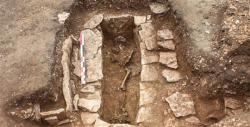 Chardonnay - À 30 centimètres près, la tombe aurait pu rester oubliée encore pendant des siècles. Pourtant, ce vendredi 6 avril, il était écrit qu’Hervé Philippe, viticulteur dans le hameau de Champvent, à Chardonnay, offrirait une belle découverte aux passionnés du Groupe de recherche archéologique du Tournugeois (Grat). Alors qu’il met en place une tractopelle pour creuser un trou dans son champ afin d’installer une barrière, la béquille de l’engin s’enfonce brusquement dans le sol. Curieux, il décide de dégager cette étrange cavité. Le godet soulève des dalles et met au jour un espace délimité par deux murets de pierre. Lorsque des ossements apparaissent, Hervé Philippe décide immédiatement de prévenir Jean Duriaud, le responsable du Grat. Dès le lendemain, avec d’autres bénévoles, ce dernier se rend sur place et constate bien vite qu’il s’agit d’une sépulture du haut Moyen Âge. Avec l’accord du Service régional de l’archéologie, une petite équipe du Grat va réaliser des fouilles durant plusieurs week-ends. Les passionnés ne sont pas au bout de leurs surprises. « On a tout de suite eu l’impression qu’on était en présence d’autres tombes, raconte Jean Duriaud. Effectivement, en fouillant de chaque côté, on a découvert deux autres sépultures. Et il y a de grandes chances qu’on soit en présence d’une nécropole, avec de nombreuses tombes disposées côte à côte ». « Ces tombes sous dalles sont difficiles à dater, avoue l’archéologue. Celles-ci sont probablement du VII e ou VIIIe siècle, donc mérovingiennes ou carolingiennes ». Selon la coutume mérovingienne, les morts étaient enterrés en dehors des zones habitées, la tête à l’ouest, le regard portant vers le soleil levant. Ce n’est que plus tard, avec le développement du christianisme, que les tombes seront regroupées autour des églises. Une datation au carbone 14 sera prochainement effectuée afin de préciser l’époque du décès. En attendant, des études seront réalisées sur les ossements. Longueur des os, forme du bassin, usure des dents… Autant d’indices qui permettront d’en apprendre un peu plus sur la taille, le sexe ou le régime alimentaire de l’occupant de la tombe. La dernière découverte d’une nécropole dans la région remonte à l’an 2000 (Collonge, à La Chapelle-sous-Brancion).
Chardonnay - À 30 centimètres près, la tombe aurait pu rester oubliée encore pendant des siècles. Pourtant, ce vendredi 6 avril, il était écrit qu’Hervé Philippe, viticulteur dans le hameau de Champvent, à Chardonnay, offrirait une belle découverte aux passionnés du Groupe de recherche archéologique du Tournugeois (Grat). Alors qu’il met en place une tractopelle pour creuser un trou dans son champ afin d’installer une barrière, la béquille de l’engin s’enfonce brusquement dans le sol. Curieux, il décide de dégager cette étrange cavité. Le godet soulève des dalles et met au jour un espace délimité par deux murets de pierre. Lorsque des ossements apparaissent, Hervé Philippe décide immédiatement de prévenir Jean Duriaud, le responsable du Grat. Dès le lendemain, avec d’autres bénévoles, ce dernier se rend sur place et constate bien vite qu’il s’agit d’une sépulture du haut Moyen Âge. Avec l’accord du Service régional de l’archéologie, une petite équipe du Grat va réaliser des fouilles durant plusieurs week-ends. Les passionnés ne sont pas au bout de leurs surprises. « On a tout de suite eu l’impression qu’on était en présence d’autres tombes, raconte Jean Duriaud. Effectivement, en fouillant de chaque côté, on a découvert deux autres sépultures. Et il y a de grandes chances qu’on soit en présence d’une nécropole, avec de nombreuses tombes disposées côte à côte ». « Ces tombes sous dalles sont difficiles à dater, avoue l’archéologue. Celles-ci sont probablement du VII e ou VIIIe siècle, donc mérovingiennes ou carolingiennes ». Selon la coutume mérovingienne, les morts étaient enterrés en dehors des zones habitées, la tête à l’ouest, le regard portant vers le soleil levant. Ce n’est que plus tard, avec le développement du christianisme, que les tombes seront regroupées autour des églises. Une datation au carbone 14 sera prochainement effectuée afin de préciser l’époque du décès. En attendant, des études seront réalisées sur les ossements. Longueur des os, forme du bassin, usure des dents… Autant d’indices qui permettront d’en apprendre un peu plus sur la taille, le sexe ou le régime alimentaire de l’occupant de la tombe. La dernière découverte d’une nécropole dans la région remonte à l’an 2000 (Collonge, à La Chapelle-sous-Brancion).
http://www.lejsl.com/edition-de-macon/2012/05/16/decouverte-fortuite-d-une-necropole-du-haut-moyen-age-a-chardonnay-(71)
IRAN – 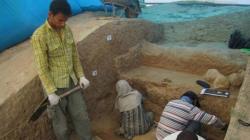 Riba Mound - Archeologists have unearthed remains of an Achaemenid residential area during excavations on an ancient mound in Iran’s North Khorasan Province. “The remains belong to an Achaemenid city spanning an area of more than 110 hectares,” IRNA quoted Mohamad-Javad Jafari of the North Khorasan cultural heritage office as saying. “Archeological evidence shows that the site had been a residential area from the Iron Age until the Islamic era,” he added saying that the most flourishing time in the history of the site was during the Achaemenid period. The Riba Mound, where the new discovery was made, also yielded remains of a Parthian castle which was built when Parthia was a political entity in Achaemenid lists of governorates. Jafari warned about vandalisms and destructions in the area blaming three brick kilns for causing damage to more than 30 percent of the historical site. The Riba Mound is located three kilometers west of Ashkhaneh in Iran’s North Khorasan Province and will host archeologists until May 20, 2012.
Riba Mound - Archeologists have unearthed remains of an Achaemenid residential area during excavations on an ancient mound in Iran’s North Khorasan Province. “The remains belong to an Achaemenid city spanning an area of more than 110 hectares,” IRNA quoted Mohamad-Javad Jafari of the North Khorasan cultural heritage office as saying. “Archeological evidence shows that the site had been a residential area from the Iron Age until the Islamic era,” he added saying that the most flourishing time in the history of the site was during the Achaemenid period. The Riba Mound, where the new discovery was made, also yielded remains of a Parthian castle which was built when Parthia was a political entity in Achaemenid lists of governorates. Jafari warned about vandalisms and destructions in the area blaming three brick kilns for causing damage to more than 30 percent of the historical site. The Riba Mound is located three kilometers west of Ashkhaneh in Iran’s North Khorasan Province and will host archeologists until May 20, 2012.
http://www.presstv.com/detail/2012/05/14/241162/archeologist-achaemenid-city-northeast-iran/
USA – 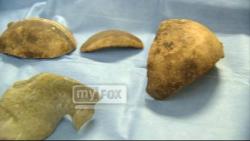 Winter Garden - When two skulls were found during construction of a Florida pool in January, authorities thought they might be dealing with a murder mystery from the 1970s. But archaeologists have determined the remains are likely centuries old -- and came from Peru. "According to archaeologists, they appear to be from South America, particularly in the Peruvian region," said Garavaglia. "And they're dating these artifacts to about 1200 to 1400." Looking back, she recalled something on the smaller skull that initially made her doubt these were from the late 1970s. "There was some mummified soft tissue which we don't usually see here in Florida," said Garavaglia. The archaeologists helping Garavaglia also used artifacts found with the skulls -- including a purse, tapestries and clay pots -- to bolster their claim that the bones are between 600 and 800 years old. Garavaglia said the backyard where the bones were found must be a second burial site, adding, "The big mystery is how did they get there, and who put them there?" The property where the bones were found used to be a migrant camp and the medical examiner said these relics could have been handed down to a worker who moved to Florida and then buried the items.
Winter Garden - When two skulls were found during construction of a Florida pool in January, authorities thought they might be dealing with a murder mystery from the 1970s. But archaeologists have determined the remains are likely centuries old -- and came from Peru. "According to archaeologists, they appear to be from South America, particularly in the Peruvian region," said Garavaglia. "And they're dating these artifacts to about 1200 to 1400." Looking back, she recalled something on the smaller skull that initially made her doubt these were from the late 1970s. "There was some mummified soft tissue which we don't usually see here in Florida," said Garavaglia. The archaeologists helping Garavaglia also used artifacts found with the skulls -- including a purse, tapestries and clay pots -- to bolster their claim that the bones are between 600 and 800 years old. Garavaglia said the backyard where the bones were found must be a second burial site, adding, "The big mystery is how did they get there, and who put them there?" The property where the bones were found used to be a migrant camp and the medical examiner said these relics could have been handed down to a worker who moved to Florida and then buried the items.
http://latino.foxnews.com/latino/lifestyle/2012/05/15/ancient-bones-from-peru-found-in-florida/
ROYAUME UNI – 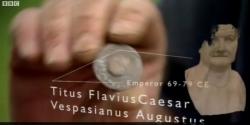 Long Melford - Relics unearthed in 40 digs around the Suffolk village of Long Melford are going on show in a new heritage centre, which opens on Friday. They will also feature in a new BBC2 series, The Great British Story, presented by the historian Michael Wood, which covers everything from DIY archaeology to preserving your own artefacts. The digs revealed the village's roots go back further than was previously realised.
Long Melford - Relics unearthed in 40 digs around the Suffolk village of Long Melford are going on show in a new heritage centre, which opens on Friday. They will also feature in a new BBC2 series, The Great British Story, presented by the historian Michael Wood, which covers everything from DIY archaeology to preserving your own artefacts. The digs revealed the village's roots go back further than was previously realised.
VIDEO = http://www.bbc.co.uk/news/uk-england-suffolk-18090705
ROYAUME UNI – 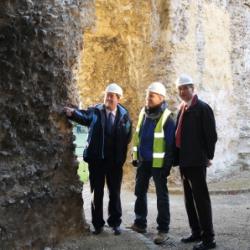 Reading - The Heritage Lottery Fund (HLF) has rejected Reading Borough Council’s grant application to establish an Abbey Quarter, linking the most historic sites in the town centre. Reading’s Abbey Quarter has been the civic and ceremonial heart of the county town of Royal Berkshire since the 12th Century. The quarter is defined by streets and rivers that outline the precincts of Reading Abbey and contains substantial standing remains and buried archaeology that can be dated back to 1121. The area shows evidence of all periods since the Abbey’s dissolution, including a royal residence, civil war defences, the school Jane Austen attended, impressive municipal buildings, Victorian public gardens and Reading Gaol, where Oscar Wilde was incarcerated. The quarter includes work by renowned architects including Sir John Soane, AWN Pugin, Alfred Waterhouse and Sir George Gilbert Scott. Significant public sculpture within the Quarter include Simond’s Maiwand Lion and statue of Queen Victoria and contemporary artworks such as the Oscar Wilde Memorial Walk and the Robed Figure sculpture by Elizabeth Frink. At the moment, the Abbey Ruins are closed to the public because their crumbling masonry has become a danger. Abbey Gate is also still closed.
Reading - The Heritage Lottery Fund (HLF) has rejected Reading Borough Council’s grant application to establish an Abbey Quarter, linking the most historic sites in the town centre. Reading’s Abbey Quarter has been the civic and ceremonial heart of the county town of Royal Berkshire since the 12th Century. The quarter is defined by streets and rivers that outline the precincts of Reading Abbey and contains substantial standing remains and buried archaeology that can be dated back to 1121. The area shows evidence of all periods since the Abbey’s dissolution, including a royal residence, civil war defences, the school Jane Austen attended, impressive municipal buildings, Victorian public gardens and Reading Gaol, where Oscar Wilde was incarcerated. The quarter includes work by renowned architects including Sir John Soane, AWN Pugin, Alfred Waterhouse and Sir George Gilbert Scott. Significant public sculpture within the Quarter include Simond’s Maiwand Lion and statue of Queen Victoria and contemporary artworks such as the Oscar Wilde Memorial Walk and the Robed Figure sculpture by Elizabeth Frink. At the moment, the Abbey Ruins are closed to the public because their crumbling masonry has become a danger. Abbey Gate is also still closed.
http://www.getreading.co.uk/news/s/2113793_reading_abbey_repair_bid_rejected
PAKISTAN - Khyber Pakhtunkhwa - Speakers at a seminar on Tuesday shed light on the rich cultural and archaeological heritage of Khyber Pakhtunkhwa with calls to create awareness among the masses to save the ancient sites from damage. Archaeology and Museums Director Dr Shah Nazar Khan talked about the excavation and preservation work at various sites in the province, including Jinnah Wali Dheri, Hunad, Jamal Garhi, Aziz Dheri, Takht Bhai and Jehanabad Buddha statue and Amluk Darra stupa in Swat. Prof Dr Abdur Rahman threw light on the historical background of various heritage sites and monuments in the province. There were graves as long as nine to 40 yards in length and date back to 45 BC like the grave of Ashab Baba in Peshawar district, Shalgazai Baba and graves in Bajaur and Khalabat, he added.
http://www.thenews.com.pk/Todays-News-7-108477-Awareness-stressed-to-protect-KPs-archaeological-heritage